Last week, I remembered stumbling upon weird items at a garage sale. Pottery mugs, sewing machines, and tall cabinets; had everything. Unaware of the sentimental and monetary value they offered, the owner was comfortable predicting that they would be a coveted prize for the right hands!
I’ve been an enthusiastic antique collector my whole life. Ranging from jewelry from the early Medieval times to 13th-century tribal masks from Africa and the Middle East to the more modern blades and sewing machines.
Whether you’ve inherited one from your grandmother or found one at your local antique store, it is human to wonder what the value of your antique Hoosier cabinet might be. An antique Hoosier cabinet is a classic everyone wishes to get their hands on!
To make things easier, I’ve come up with a guide addressing all of your queries regarding Hoosier cabinets. This includes explaining what a Hoosier cabinet is, a look into its history, methods to identify your cabinet, its value, and finally, how much you might be able to sell it for.
Table of Contents
What Is a Hoosier Cabinet?
A well-built, durable cabinet during the 1900s, the Hoosier was more than a regular kitchen cabinet. In addition to the upper and lower storage spaces for everyday commodities such as rice, flour, sugar, and spice, it had fixed and movable parts to make life easier for its owner.
The movable parts included a flour sifter, meat grinder, dish rack, spice rack, sugar sifter, cookbook holder, a breadboard, and an impressive nutrition chart. Given the context of their invention, they had a distinct look!
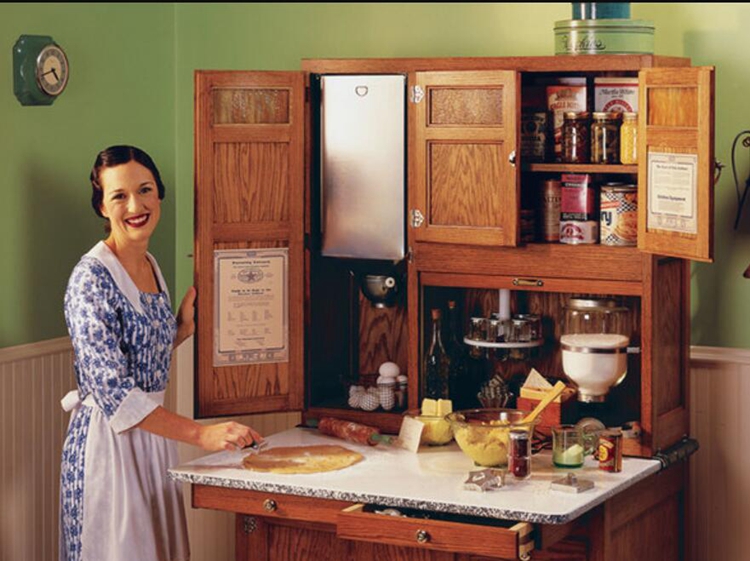
More Hoosier models had an impressive design with an aluminum work surface and a porcelain top finish. Depending on the model, the shelves had either a blind front or glass doors.
The design makes it clear that Hoosier cabinets were developed with the sole aim to make cooking and baking much easier for everyone by having everything you needed in one place. Given the context of their invention, they had a distinct look!
In short, a Hoosier is a 1oo-year-old kitchen cabinet. Although the classics are no longer produced, they are appealing and valuable to hobbyists and collectors.
History of the Hoosier Kitchen Cabinet:
Brief Overview:
The Hoosier kitchen cabinet first appeared in the market in 1898, when a furniture company going by the name “Sellers” produced it in New Castle, Indiana.
The design offered a complete and vital experience for a workplace. It grew extremely popular with other manufacturers, who undertook its production and created models similar to it.
The production showed an uptrend in its growth until the 1940s-1950s, when the company ceased production of the cabinets.
You can learn about the history of the Hoosier kitchen cabinet by clicking here!
Where Does the Name Hoosier Come From?
While many different and contrasting theories exist about the history of the name, most experts believe that they were named so because of the state they were invented in, i.e., Indiana going by the nickname, the Hoosier state.
Others believe the company took a more straightforward approach and named it after themselves, The Indiana Manufacturing Company.
However, it is probably the former that made its way to the basis of naming the cabinet, as the word Hoosier has been linked to the state of Indiana for more than 150 years. Its origin comes from folklore involving people shouting “Who’s there?” across the Wabash River or the tale of a man who lost his ear in a bar fight, someone picking it up afterward and shouting “Whose ear?”. Both the phrases sound similar to Hoosier.
When and Where Was the Hoosier Cabinet Invented?
Hoosier cabinets became popular in the 1900s when their true potential was realized by home and restaurant owners.
This problem was eventually extensively highlighted and led to the birth of the Hoosier kitchen cabinet in the state of Indiana in 1898. It immediately took off and became a rapid success until the 1950s, when it was slowly replaced by newer models that offered more spacing and were more convenient.
Although there is a fair amount of mystery surrounding the name, all experts agree on the fact that the cabinet was, in fact, birthed in New Castle, Indiana.
The Purpose of Creation of Hoosier Cabinets?
In the late 18 and early 1900s, kitchens rarely harbored enough space to provide for cooking, let alone storage. As such, many American homes and families could not store everyday staples. Similarly, kitchens did not feature enough cabinetry to hold enough space for cooking and baking supplies during this period.
These issues were undertaken by Indiana Sellers, a furniture manufacturing company, which came up with the idea of providing homeowners with standing baking cabinets. This was translated to a product in 1898 when the first Hoosier kitchen cabinet came into being!
Hoosier cabinets were the perfect mix of functionality and aesthetics, quickly becoming a part of almost every American household. Their combination of fixed and movable parts became extremely popular as people were accustomed to having storage and counters in different places. According to the company, they have saved the American housewife more than 1500 steps a day.
In short, these cabinets were produced to make the life of homeowners easier because a worker is only as efficient as their workplace!
Who Created the Hoosier Cabinets?
The first kitchen cabinets were manufactured by the Indiana Sellers Company, realizing the true potential and need of the hour.
The popularity of the furniture quickly grew and was soon produced by 40 other companies, all based in the State of Indiana.
The Hoosier Manufacturing Co was the most significant kitchen cabinets supplier and was pumping out a remarkable 600 cabinets a day, selling 2 million units by 1920. Among other companies manufacturing the cabinet, prominent names included G.I. Sellers, The McDougall Company, Coppers Brother and Zook, Diamond Kitchen Cabinets, Wilson Kitchen Cabinet, and Campbell-Smith-Richie.
However, many experts acclaim the Hoosier Manufacturing Company for the cabinets, the name generally refers to the style and design of the kitchen cabinet and less to the original furniture manufacturers.
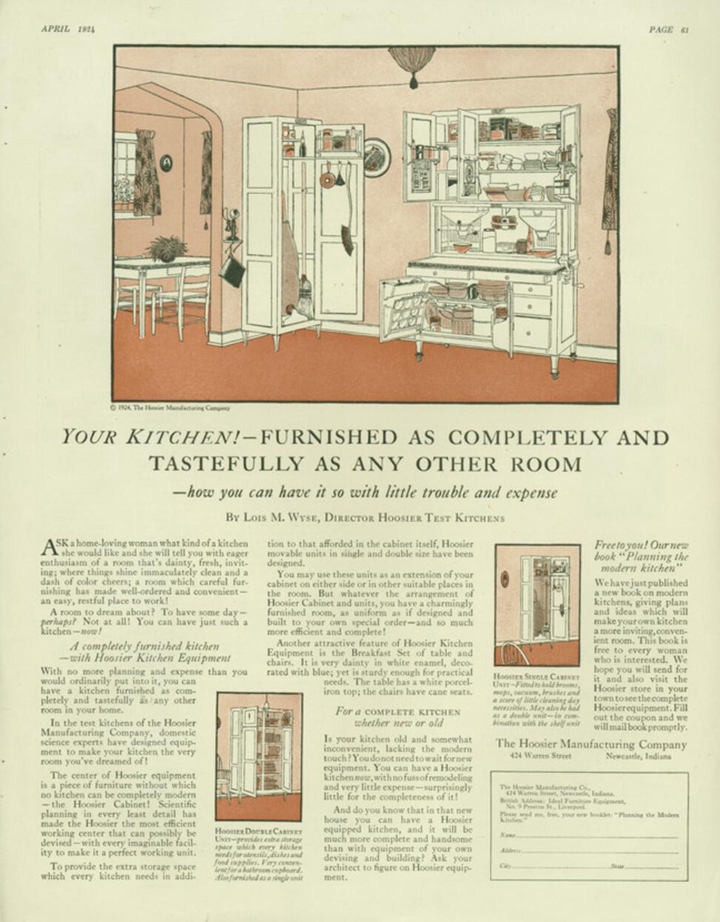
The Downfall of Hoosier Kitchen Cabinets:
Following its rapid success during The Great Depression, the popularity of the kitchen cabinet gradually declined, owing to better designs and the introduction of kitchen and storage units.
The original Hoosier Manufacturing Co was eventually sold in 1942 and then liquidated, so details about the company are now quite rare.
Antique Hoosier Cabinet Identification:
The 1920s antique Hoosier cabinet is regarded by collectors as a focal point of a retro-themed kitchen. This antique piece is so popular among enthusiasts that it is frequently redesigned by vintage artisans.
However, it is worth noting that these cabinets are so loved by enthusiasts that they’re frequently reproduced. So, suppose you’re looking for a specific antique piece, or you’ve decided to sell your kitchen cabinet. In that case, you must consider a couple of things, so you don’t sell your piece too short.
Observe the Style and Design:
An example of remarkable design and craftsmanship, antique Hoosier cabinets are duplicated by talented craftsmen. The first step in the identification process is to look out for the classic three-compartment design. This includes a shallow upper cabinet, deep lower cabinets, and a workspace with a porcelain top.
Interior:
The workspace includes a flour sifter, jars for spices and other commodities, and a sugar sifter.
It is also essential to observe the drawers above or below the workspace. They were intended for bread and were lined with tin.
Exterior:
Most antique Hoosier cabinets were 6 feet tall, 4 feet wide, and about 2 feet deep. Measure your cabinet to make sure it fits the dimensions.
Initially, Hoosier cabinets were made using oak, but as demand increased, oak became scarce, and the prices soared. Manufacturers then started using alternatives such as pine, walnut, white maple, and enamel. It was common to see a kitchen cabinet made using three different types of wood.
The colors most commonly used on the wood were apple-green and ivory. However, as the use of oak wood declined, companies started using different colors to divert attention from the quality of wood used.
Note: While identifying your kitchen cabinet, carefully examine the accessories and the top and bottom to ensure they’re made by the same manufacturer and material. It is common to find kitchen cabinets with mismatched accessories and parts, significantly decreasing their value.
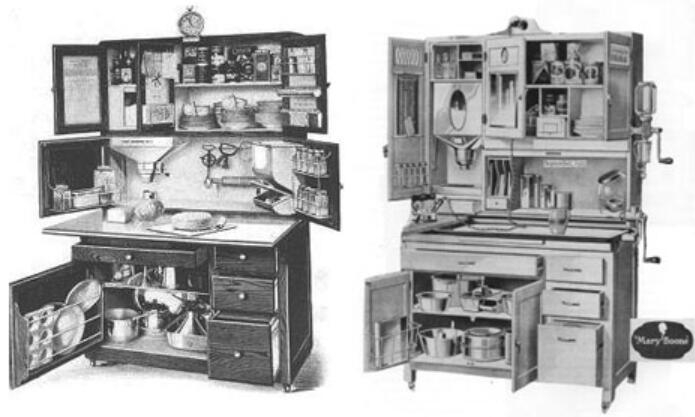
Look For Accessories:
After their remarkable design, Hoosier cabinets are known for the extensive accessories they provide. These include racks and compartments for storage, a floor bin combined with a sifter, a sugar sifter, and storage.
Some cabinets even came with glass jars for additional storage, breadboards, ant traps, hooks for pans, and pot racks.
Many collectors believe that the charm and appeal of Hoosier kitchen cabinets come from their accessories. However, in all probabilities, the cabinet you’re looking for has lost some, if not most, of its accessories over time. This may reduce the value of the cabinet in the eyes of a potential buyer.
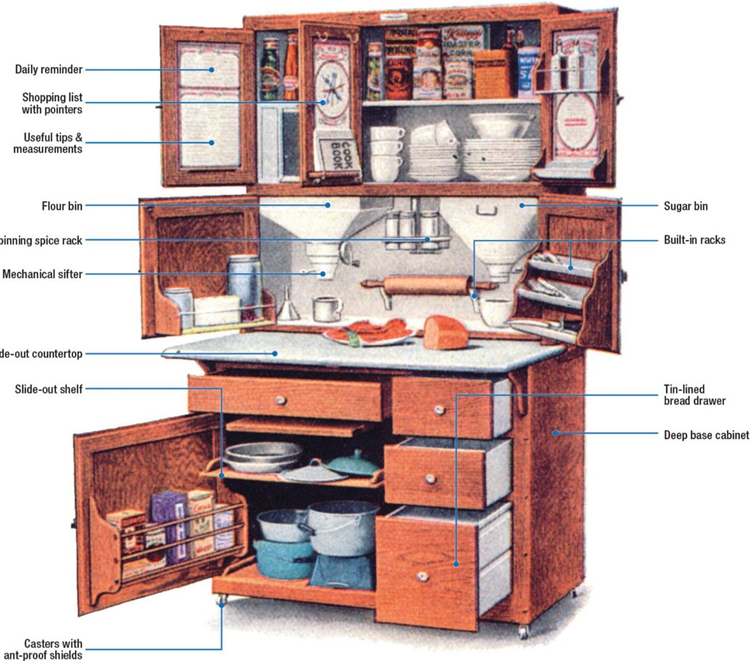
The Manufacturer’s Mark:
All genuine Hoosier cabinets have a manufacturer mark somewhere on the cabinet. A simple stamp or a metal plate might be visible on the cabinet. Most markers included a company name, logo, manufacturing date, or patent number.
As mentioned, Hoosier cabinets were produced by quite a list of companies, each with their distinctive mark at a specific place. The Hoosier Manufacturing Company’s mark was an H on the fastener doors.
Finding the manufacturer’s mark can help you quickly identify your Hoosier cabinet and assess its value.
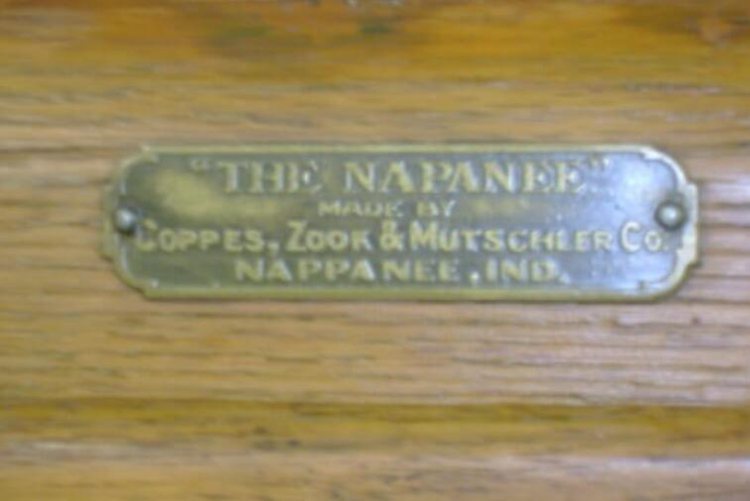
Other Sources:
Books and Publications:
If you come across specific Hoosier cabinet models, you can easily find related details using guides. Distinct books such as “The Hoosier Cabinet In Kitchen History” can provide information on all the Hoosier cabinets ever made. You can order it from Amazon by clicking here!

“Hoosier Cabinets” by Philip D. Kennedy is another publication that you will find helpful in your quest for a Hoosier cabinet. The author claims to have included all relevant history of Hoosier, Sellers, Napanee, McDougal, Boone, and other cabinets. He has also included original magazine ads and sales literature. This publication is a must-have if you’re attempting to identify your old kitchen cabinet. You can order it from Amazon by clicking here!
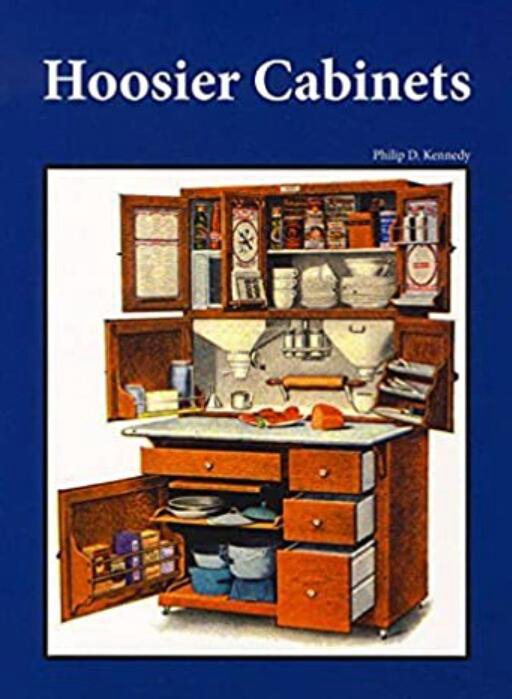
“Indiana Cabinets” is a book that includes colored photographs and a detailed guide on the value of your kitchen cabinet. It also covers multiple companies, including Hoosier, Sellers, McDougall, and Napanee. You can order it from Amazon by clicking here!
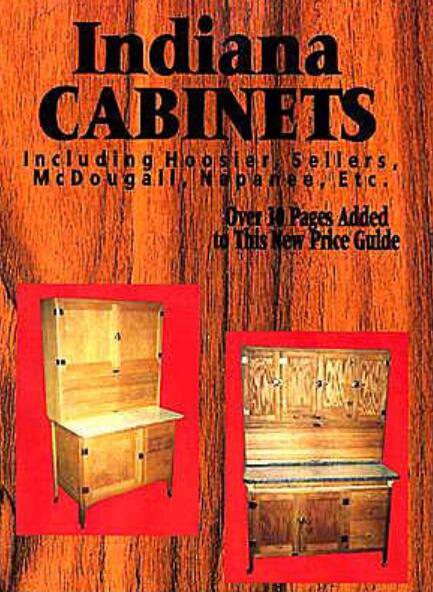
Online:
You can also use a source such as HoosierCabinet to find pictures and information regarding your model. The company lists thousands of vintage ads of the kitchen cabinet, including original images and sales prices.
Value of Hoosier Kitchen Cabinets:
Assessment:
Suppose you’re thinking of buying/selling a Hoosier kitchen cabinet or keeping one to pass down the generations. In that case, it is vital to know its value.
Hoosier kitchen cabinets were made at the end of the 19th and the beginning of the 20th century, so the price is based more on their functional and aesthetic reliability and less on time.
Considered an antique and vintage item, several factors influence the price you may get for an antique Hoosier cabinet. I will give a detailed description of the things you need to look out while assessing its value:
Condition:
As with all vintage items, this is the foremost factor that drives the value of a Hoosier kitchen cabinet. The better the condition, the higher price your cabinet will fetch.
It is important to note that depending on the condition, your kitchen cabinet can fetch somewhere between $200-2000.
Accessories:
As you have figured it out by now, a Hoosier kitchen cabinet came with a ton of accessories. If the piece of furniture comes with its accessories packed, the value will sky-rocket! Some kitchen cabinets came with rare accessories, such as meat grinders, further elevating the value of your piece.
For example, in 2020, a Hoosier cabinet with no manufacturer identified but with all of its original accessories packed in the sublime condition sold for $1500 on eBay.
However, it is highly improbable that the accessories have survived the test of time. Sometimes vintage parts are added to antique cabinets, which may be mistaken for original accessories. You need to keep an eye out for such fraud by following the guidelines for identifying a Hoosier kitchen cabinet covered in this guide.
Wood:
The make of the cabinet, i.e., the material used for its manufacturing, also greatly influences the price.
As this article covers, the oldest Hoosier cabinets were made using oak wood. Once it became scarce, it was replaced by cheaper forms such as maple, pine, walnut, and enamel. Hoosier kitchen cabinets made of oak and walnut tend to fetch higher prices than their counterparts.
Originality:
When it comes to valuing a Hoosier cabinet, the originality of its parts and accessories significantly affects the price it will fetch from a potential buyer. This is because some owners of some kitchen cabinets might have changed their parts for functional or aesthetic reasons.
Moreover, an antique kitchen cabinet in a fair condition but with its original accessories intact will be valued at a much higher price than a cabinet in excellent condition but with its parts/accessories repaired or replaced. This explains the importance of the accessories delivered with the cabinet.
Note: If you’re an antique collector or looking to buy a Hoosier cabinet for your home, the top and the bottom parts are frequently with the same material and the same manufacturer.
Value Estimation:
After carefully assessing the factors mentioned above, you can make an educated guess about your kitchen cabinet’s value. In general, original antiques in perfect condition can fetch around $2000, while one requiring restoration will fetch only about $200-300.
You can use the online platforms already mentioned in this article to get an idea about the price of your kitchen cabinets.
Furthermore, the books and publications listed above can provide you with an estimate based on the model and condition of your Hoosier kitchen cabinet.
Where to Buy and Sell Hoosier Kitchen Cabinets:
Buying and selling Hoosier-style kitchen cabinets is slightly tricky, considering the large size of the piece that needs to be shipped. So, you might want to source it locally, either online or at local antique stores. However, if you decide to buy at a considerable distance, make sure you look at the shipping costs before ordering.
The best sources to buy and sell Hoosier cabinets are:
Antique Stores:
An antique store might be the best option when purchasing a kitchen cabinet as it allows you to check every part, in person, before bringing it home. You can go to your local antique store or contact someone (an antique dealer) who may be able to assist you.
Auctions:
Live auctions at your nearest auction sites may have a piece waiting for you. People who are getting rid of family heirlooms usually list them for lower prices at garage sales and auctions. Don’t miss them if you’re looking out for an antique piece.
Online platforms:
eBay: You can find a variety of Hoosier-styled kitchen cabinets on eBay, both in original and modified forms. Similarly, parts are also available in case your kitchen cabinet requires restoration.
A Hoosier cabinet “the Nappannee” by Coppe, Zook, and Mutschler Co. is listed on eBay at $999.
Etsy: This website has an excellent antique section. You can look for a kitchen cabinet in its original state or one with replaced parts. Etsy provides pre-owned, as well as new cabinets.
A pair of vintage Sellers or Hoosier-style kitchen cabinet spice jars are listed for $19.95
Craigslist: is the best advertising site and has a brilliantly developed antique section. You can also put up an ad describing the kitchen cabinet you’re looking for.
LiveAuctioneers: The best treasure-hunting site, the platform offers the most extensive collection of antiques, including your coveted Hoosier-style kitchen cabinet. It provides an artistic marketplace to shop from and frequently lists kitchen cabinets and accessories.
A Hoosier self-contained kitchen baking cabinet is currently estimated at $400-800.
Christie’s: Another auction site, Christie’s, provides a comprehensive list of antique items for sale. You can also find glassware and accessories for restoration by searching for a specific item.
GoAntique: It is another online antique store that frequently has Hoosier-style kitchen cabinets and accessories for sale.
A Hoosier-style cheese nutmeg grater is listed at $35 on GoAntique.
Alternatively, you can use the Facebook Marketplace to find a seller/buyer near you. Or contact online antique dealers, who would gladly take the cabinet off your hands (though not at a price of your comfort). Finally, you can use social media platforms to announce your desire to sell.
Final Thoughts:
An integral part of American households in the 1900s, Hoosier-style kitchen cabinets was America’s contribution to kitchen décor. The beautiful design wasn’t the only reason for the rising popularity of this cabinet. Still, phrases such as “The Hosier Cabinet Saves Steps” and “The Hosier will help me to stay young” were famous punchlines successfully marketed by the company.
The invention of the built-in kitchen cabinets bought an unfortunate end to this beauty. However, the sentimental, aesthetic, and nostalgic value still prolongs its popularity today.
Owing to its classical aesthetic appeal, if you’re looking for something to uplift your kitchen or dining room, this might be the perfect antique beauty to complement your household!
From providing staple storage to American families to an antique collector’s item and home décor, the Hoosier kitchen cabinet has undoubtedly come a long way!





![Where To Sell Antique Furniture In 2022 [Ultimate Guide]](https://www.jacquelinestallone.com/wp-content/uploads/2022/09/Etsy-Your-Place-To-Buy-And-Sell-All-Things-Handmade-600x450.jpg)


